�Ӧ� �y����
�S�� 1345.2�S
�o�� 699
���U 2004/9/6 �U
�q�� �W���q��
����������

|
By Lorenzo F. Castiglioni
�iPreface�j
There is a very big confusion about bodybuilding, and the thoughts of the
"normal" people about this sport are full of misunderstandings. Someone thinks
that bodybuilding is a very modern discipline and other say that this sport is
"of no use".
I don't want to talk about the "utility" of bodybuilding. I only think that it's
like the other sports. You can say, for example, that football is useful and
baseball not. In my opinion, everyone can have a personal idea of this and other
and more important questions of life.
The intention of this page, as you can see from the title, is not to speak about
the philosophy of bodybuilding, but the history of this sport. Truly speaking,
as you will see in chapter one, a very ancient sport, since the use of weights
and the ideal of beauty followed by modern bodybuilders was known also by the
Greeks more than three tousands of years ago.
You will see in chapter two how in the 19th century, men like Hyppolite Triat
and Eugen Sandow built an extraordinary body with restricted knowledges in fact
of training and diet. In chapter three we will talk about bodybuilding in the
first years of 20th century, while in chapter four we will discuss the evolution
of this sport after the second war and about the competition of NABBA Mr.
Universe.
In chapter five, we will talk about the competition of Mr. Olympia and the
golden era of bodybuilding: the 60s and the 70s. In the next chapter we'll
discuss the evolution of this sport in the 80s, while the last chapter is
dedicated to the 90s.
This site is best viewed in 800x600 resolution and in full screnn mode. To allow
full screen mode, press F11 on Internet Explorer browser. The links in this
history point to the glossar or to the gallery, while at the end of every
section you can find a list of interesting websites related to the chapter.
�iChapter one. Ancient history of bodybuilding.�j
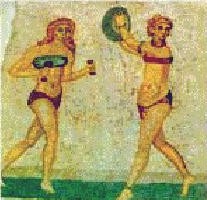
It is out of question that in the antiquity, strength played a central role. In
spite of the invention of some weapons, the most important of these was, for
millenniums and millenniums, the man's force.
We don't know exactly when a man (or more men) noticed that, weighting lifts, he
could be stronger. But looking at some pictures and exhibits of the ancient
Greeks, we could notice something similar to modern dumbbells.
But there's no need to see these pictures, since everyone knows that the greek
statues represent often muscular bodies, and that's the evidence of an ideal of
beauty, proportions and aesthetics followed in that period.
That's the difference between bodybuilding and pure weightlifting. The latter
considers weights as a mean to conceive a bigger musculature and an armonic
body; the last considers weights as a goal. I think that also primitive men were
in the habit to lift massive stones to demonstrate their force, but there was no
other intention related to this activity.
The ancient Greeks, however, used regular exercise to maintain the body in
perfect conditions and they invented also some primitive dumbbells. The culture
of body, professed in that period, was an exception, because it was extended to
all the population, while later this idea was followed only by some classes of
people.
Also Romans were in the habit to practice exercise, but they were too lazy. Only
gladiators and praetorians used weightlifting. As Eugen Sandow says: " To their
laxity in the matter of Physical Cuture in later years, may, in a great misure,
be attributed the main causes of the downfall of the Roman Empire. "
�iChapter two. The comeback of bodybuilding.�j
In the middle age, the ideals of beauty and aesthetics were lost. These
centuries were dark and full of sickness and dearth. So, we could say that only
in the beginning of 19th century, bodybuilding returned.
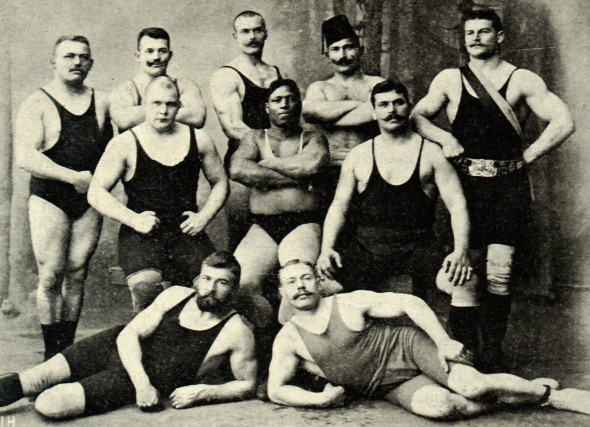
A group of russian strongmen. The strongmen
were the pioneers of modern bodybuilding. They were poliedric personalities,
being weightlifters, wrestlers, circensians and sometime actors. The last man on
the right (up) is Viktor Solevev, a world famous wrestler in the beginning of
20th century.
Hippolyte Triat
The French Hippolyte Triat (1813 - 1881) affirmed that using dumbbells a man
could sculpt his body. The idea of "french training" was born in this period:
Triat discommended the use of heavy weights to prevent accidents, so also today
we associate the word "french training" with the idea of light weights and a
very high number of repetitions .
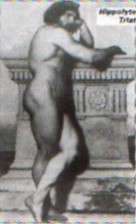
Hyppolite Triat. He used the first dumbbell of 84
kg (185 lbs.), built in 1838. Truly speaking, the dumbbell would have been 90
kg, but the second sphere was littler than the first, so that this tool was
asimmetric and difficult to use. This dumbbell is conserved in the "Musée de
l'Homme" in Paris. Only Triat and Cadine, another french weightlifter, were able
to lift this tool with one arm.
Eugen Sandow (Friedrich Wilhelm Müller)
The opposite ideas of Triat were followed by german and austrian weightlifters.
Friedrich Wilhelm Müller (1867 - 1925) used heavy weights and short trainings
(15 minutes each) to stimulate muscles. Müller was the father of modern
bodybuilding and also a very cunning businessman.
He was born in Königsberg, in Prussia (now Kaliningrad in Russia) and, still
adolescent, he visited the whole Europa, working as circensian. In 1887, he knew
in Bruxelles the German Louis Attila (which the real name was Louis Durlacher),
a very famous strongman. Attila was a pupil of Triat, and created an high number
of exercises. In 20th century, Attila went to New York and there opened a gym.
Attila, working with some german colleagues, founded the basis of structured
training: they understood that using weights and increasing them in a structured
and sistematic way, the body's muscles could grow.
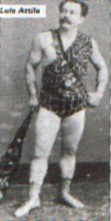
While Triat made the first modern dumbbell of 84 kg, Attila and Karl Abs (1815 -
1895), another german strongman, created the first modern barbell. Using this
tool, Attila invented very effective exercises, since they were simmetric and
stimulated equally left and right muscles.
Another advantage of the barbell is that it's possible to increment weight using
the same bar, while the dumbbell's weight is fixed.
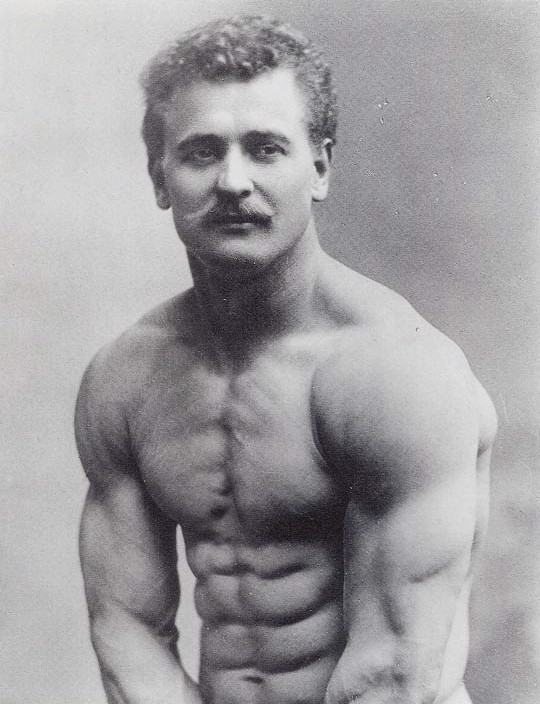
Müller was a strong man, stronger than Attila, but also stronger than Charles
Sampson, an english man, who substained to be the "strongest man in the world".
After years of training with Attila, Müller was ready to go to London to
challenge Sampson and his pole pupil Franz Bienkowski (also known as the
Cyclops) and he demonstrated to be stronger than them.
After this exploit, Müller changed his name into Eugen Sandow. In London, he
built the first modern gymnasium at 32, St. James Street, but as I've said, he
was very cunning. While the other gyms were dirty and only for brutal men,
Sandow's gymnasium were clean and reserved to a particular class of clients -
the richest ones.
Sandow used very high weights to increase his force and to build muscles, but he
trained his clients very softly. Only a little part of Sandow's clients
practiced really body-building. However, in a separate room !
At page 5 of Body-building, or man in the making, a book of Sandow, we read: "
It was in the beginning of 1897 that I opened my first school of Physical
Culture [...], but since then the demand has been so great from those who prefer
to do their work under the watchful eye of an efficient, qualified instructor,
that I have been compelled to considerably enlarge my Institute, and in addition
I have organised a system of postal instruction, of which residents in all parts
of this country and abroad are extensively availing themselves. " So with Sandow
was born a particualar kind of business: the courses by correspondeance. As you
will read in next chapter, also an italian man, expatriate in USA, became rich
and famous with the "Dynamic Tension TM" course, another "system of postal
instruction".
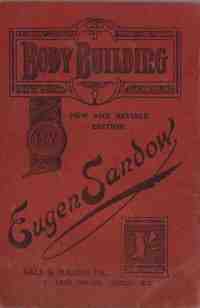
Sandow's essay on bodybuilding. In the first page
of this book, there are some kinds of diets. Sandow advises to eat cereals, meat
and vegetables. To increase the apport of protein in the diet, Sandow recommend
to use "Plasmon" (egg white's powder). Thus, we are in front of the first
integrator of the history !
While the ideas of Sandow - the man - are desputable, his ideas about
bodybuilding are intersting and very modern. He wrote also some books about this
sport; the most important are: Strenght, and how to obtain it and Body-building,
or man in the making, which describes many exercises. He was a friend of Sir
Arthur Conan Doyle, the author of Sherlock Holmes books. Conan Doyle wrote the
preface of the Sandow's book The construction and reconstruction of human body.
Sandow had a wife, Blanche Brookes, and two daughters, Helen and Lorraine, but
in New York he lived with his male friend Martinus Sieveking (1867-1950), a
music composer born in Amsterdam and one of the first bodybuilders.
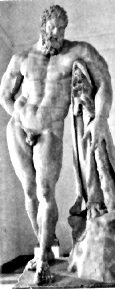 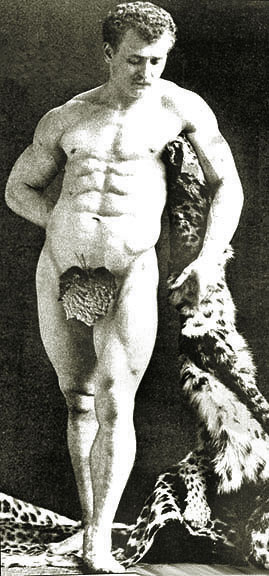
Left: The colossal statue of "Ercole Farnese",
conserved in the National Museum of Napoli, Italy. Right: Eugen Sandow in the
same pose (1898). He wrote, in his book Body-Builing, or man in the making:
"amongst the many fine statues is that of the Farnese Hercules, from the
contemplation of which during a visit to the museum that I first conceived the
idea of developing my body to the same pitch of perfection as was represented in
the antique sculpture."
Sandow, Doyle and Sir Charles Lawes (a sculptor of London) made in 1901 the
world's first competition of bodybuilding in Royal Albert Hall of London. The
winner was a man of Birmingham, W. L. Murray, who received a little statue
representing Sandow himself. It's intersting to notice that, 64 years later, a
similar statue was given to Larry Scott, the winner of 1965 Mr. Olympia and
every year this statue is given to the winner of this competition.
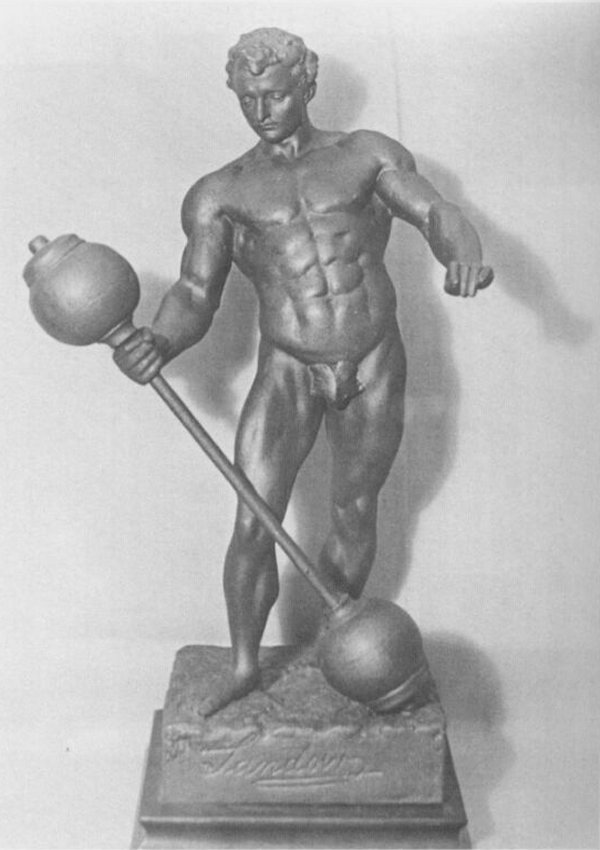
Bodybuilding in the rest of Europe
In 1890 in Milan (Milano, Italy) was born the first club of weightlifting: the
so called "Club Atletico Milanese", created by Luigi Monticelli Obizzi. A famous
italian strongman, migrated in USA, was Clevio Massimo, who wrote the book
Modern Hercules.
In Austria, Franz Stoher and Karl Böhling were the pioneer of bodybuilding. As
we have said, Sandow promoted this sport in England, while in France this was
done by Triat and in Germany by Abs.
In Russia, Dr. Krapewsky, doctor of the Zar, promoted the training with weights.
One of his pupil was George Hackenschmidt - Lion of Russia - the inventor of the
"Hack Squat" machine and a very famous wrestler.
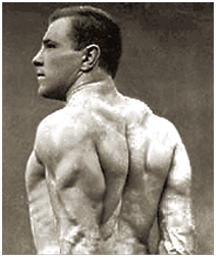
George Hackensmidt. His invention, the "hack
squat" machine, is used also today, as a mean to train legs in a more safer
way."
�iChapter three. The beginning of 20th century.�j
As we have seen, bodybuilding was born in Europe in the second half of 19th
century. In the USA, the situation was different. While in Europe men like
Sandow trained themselves to concieve muscles and force, in the USA it was the
healt's movement to promote exercise.
We can say that the bodybuilding arrived in the United States at the beginning
of 20th century. Sandow himself went to Chicago in 1894 to pose as a greek
statue in the World Fair and to make a show, the so called "Sandow Trocadero
Vaudevilles", in which he demonstrated his force and showed his muscles.
Sandow visited a lot of countries, promoting bodybuilding. Obviously, he had
some interest doing this: he invented the "Sandow's dumbbell", a particular kind
of dumbbell made of springs, and he send a manual about this tool to the
families of all the kingdom and sovereigns of Europe.
As I've said, Sandow was a very cunning businessman. The following images
illustrate this concept.
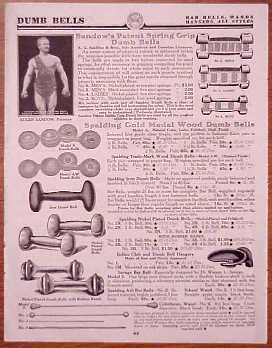 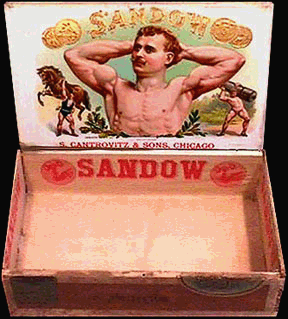
Left: An advertisment of Sandow's dumbbells.
Right: A box of Sandow's cigars."
Charles Atlas
At the beginning of 20th century we have the first important competition of
bodybuilding. In fact, in 1903, Bernarr McFadden promoted the first edition of
America's Most Perfectly Developed Man. The price for this competition was
$1'000, a considerable fortune.
The competion was opened to athlets of all disciplines, but it was manifest that
the best bodies were built with weights and not with other kinds of exercise.
The winner of the first edition was Al Treolar, while Beatrice Marshall won the
prize for the best woman.
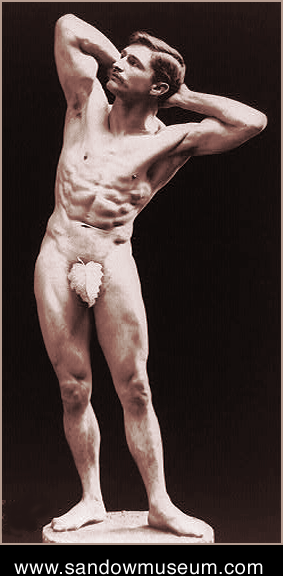
Bernarr McFadden. Photo of 1893."
Bernarr McFadden substained that the physical weakness is an immoral fact and
founded the revue "Physical Culture" to promote his ideas. He continued to
pratice his ideas, running shoeless from Riverside Drive in New York to the
center of the city, up to the age of 70 years.
The winner of 1921 edition was Angelo Siciliano (1893 - 1972). A skilful
copywriter, Charles Roman, suggested him to change his name into Charles Atlas.
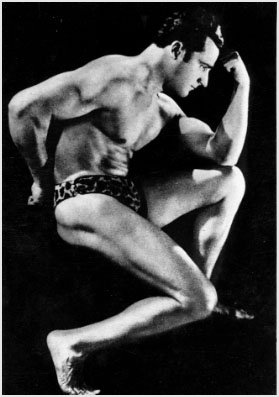
Angelo Siciliano (Charles Atlas). He posed as a
model for 75 statues and trained Rocky Marciano, Joe di Maggio and Robert
Ripley. "Dynamic Tension TM" exists also today."
Atlas was an italian boy expatriate in America, and became very rich and famous
inventing the course of "Dynamic tension TM". This course was translated into
seven languages and was bought by more than 60 thousand people every year. It
consisted in exercises for the various muscles of the body. Truly speaking,
Atlas used weights and not "Dynamic tension TM" to build his muscles; however,
the exercises were effective. A curiosity: Siciliano took inspiration for
"Dynamic tension TM" looking the exercises done by the animals in a zoo.
Atlas won the competition of Most Perfectly Developed Man also in 1922. The
measures of his body were: chest 120 cm, thight 60 cm, waist 81 cm, biceps 43
cm, neck 43 cm.
Compare this measures with Sandow's at the age of 32: chest 124 cm, tight 63 cm,
waist 91 cm, biceps 45 cm, neck 44 cm. Thus Sandow was massiver than Atlas.
Sigmund Klein
As we have said in the previous chapter, Attila openened a gym in New York. A
german boy migrated to Cleveland (Ohio, USA), Sigmund (Sig) Klein (1902 - 1987),
went to the Attila's gym to know the famous strongman. Unfortunately, Attila
passed away only a short time before.
The gym was closed, but Klein spoke with Attila's widow and obtained to re-open
the gym. He tested exercises and equipments, understanding the best of them to
concieve results in a short time. Some of these results are valid also today.
Klein married Attila's youngest daughter and then he opened his own studio. It
was a trainer of great champions, also Steeve Reeves and John Grimek.
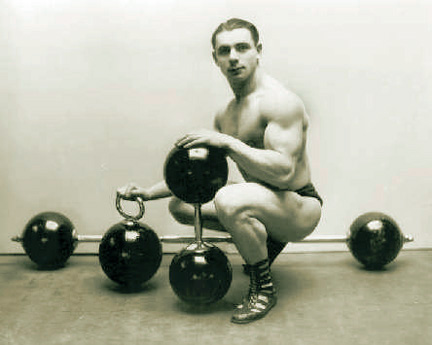
Sigmud Klein. You can see a barbell (rear,
horizontal), a dumbbell (in Klein's left hand, vertical) and a shot with an
handle - also known as bell (in Klein's right hand)."
The first competitions of bodybuilding
The competition of Mr. America was the world's most important competition for
many years. Up to the second world war, there was not a great distinction
between bodybuilding and weightlifting. Truly speaking, the competition of
bodybuilding were done in the night, after weightlifting competitions.
In fact, AAU (American Athletic Union) forced the bodybuilders to make first the
lifts and then the poses. A similar situation was surely frustanting for the
first bodybuilders: they were obliged to pose in the night, when almost all the
spectators were already gone home.
The first edition of Mr. America (America's finest physique) was promoted by
Johnny Hordines in 1938 and was won by Bert Goodrich. Goodrich won also the next
edition.
From 1940, Mr. America was promoted by AAU. The first AAU Mr. America was the
great John Grimek (see next chapter).
This table displays the measurements of the first Mr. America winners (font:
Muscle Memory by Tim Fogarty). Measurements are in feet and inch (' and ") and
in cm for lenghts, in pounds (lbs.) and kg for weights.
�@
| Year |
Name |
Height |
Weight |
Neck |
Arm |
Forearm |
Chest |
Waist |
Thigh |
Calf |
Wrist |
Ankle |
| 1939 |
Bert Goodrich |
5'10.5" 179 cm |
195 lbs. 88.45 kg |
17" 43.18 cm |
17" 43.18 cm |
14" 35.56 cm |
47" 119.38 cm |
33" 83.82 cm |
24" 61 cm |
17" 43.18 cm |
7.6" 19.3 cm |
9.2" 23.36 cm |
1940
1941 |
John Grimek |
5'8.5" 174 cm |
195 lbs. 88.45 kg |
17" 43.18 cm |
17.5" 44.45 cm |
14" 35.56 cm |
47" 119.38 cm |
31" 78.74 cm |
25" 63.5 cm |
17" 43.18 cm |
8" 20.32 cm |
9.8" 24.89 cm |
| 1942 |
Frank Leight |
5'11.5" 181.61 cm |
209 lbs. 94.8 kg |
17.5" 44.45 cm |
17.5" 44.45 cm |
14" 35.56 cm |
48.5" 123.19 cm |
33" 83.82 cm |
24" 61 cm |
16" 40.64 cm |
8" 20.32 cm |
9.5" 24.13 cm |
| 1943 |
Jules Bacon |
5'7" 170.18 cm |
175 lbs. 79.37 kg |
15.5" 39.37 cm |
15.5" 39.37 cm |
12.5" 31.75 cm |
44" 111.76 cm |
31" 78.74 cm |
23" 58.42 cm |
15" 38.1 cm |
7" 17.78 cm |
9" 22.86 cm |
| 1944 |
Steve Stanko |
5'11.5"
181.61 cm |
223 lbs.
101.15 kg |
18"
45.72 cm |
18"
45.72 cm |
14.3"
36.32 cm |
48.5"
123.19 cm |
35.9"
91.18 cm |
N.A. |
17"
43.18 cm |
8"
20.32 cm |
10"
25.4 cm |
| 1945 |
Clarence Ross |
5'9.5"
176.53 cm |
185 lbs.
83.91 kg |
16.5"
41.91 cm |
17"
43.18 cm |
13.5"
34.29 cm |
47"
119.38 cm |
32"
81.28 cm |
24"
61 cm |
16"
40.64 cm |
7.5"
19.05 cm |
9.2"
23.36 cm |
| 1946 |
Alan Stephan |
5'11.5"
181.61 cm |
205 lbs.
93 kg |
17.1"
43.43 cm |
17"
43.18 cm |
14.2"
36.07 cm |
47.9"
121.66 cm |
32.4"
82.29 cm |
24.8"
63 cm |
16.1"
40.89 cm |
7.7"
19.55 cm |
9.7"
24.63 cm |
| 1947 |
Steve Reeves |
6'1"
185.42 cm |
213 lbs.
96.61 kg |
17.6"
44.7 cm |
17.5"
44.45 cm |
14"
35.56 cm |
48"
121.92 cm |
31"
78.74 cm |
25.3"
64.26 cm |
17.5"
44.45 cm |
7.9"
20.06 cm |
9.8"
24.89 cm |
| 1948 |
George
Eifferman |
5'7.5"
171.45 cm |
195 lbs.
88.45 kg |
16.5"
41.91 cm |
16.7"
42.41 cm |
13.4"
34.03 cm |
47.5"
120.65 cm |
32"
81.28 cm |
25"
63.5 cm |
16"
40.64 cm |
7.3"
18.54 cm |
9.6"
24.38 cm |
| 1949 |
Jack Delinger |
5'6"
167.64 cm |
195 lbs.
88.45 kg |
16.8"
42.67 cm |
17.2"
43.68 cm |
13.8"
35.05 cm |
47.5"
120.65 cm |
32"
81.28 cm |
25"
63.5 cm |
16.6"
42.16 cm |
7.7"
19.55 cm |
9.5"
24.13 cm |
| 1950 |
John Farbotnik |
5'9"
175.26 cm |
195 lbs.
88.45 kg |
16.8"
42.67 cm |
17"
43.18 cm |
13.5"
34.29 cm |
47.5"
120.65 cm |
32"
81.28 cm |
24.5"
62.23 cm |
15.7"
39.87 cm |
7.5"
19.05 cm |
9.3"
23.62 cm |
| 1951 |
Roy Hilligenn |
5'6"
167.64 cm |
178 lbs.
80.74 kg |
16.6"
42.16 cm |
16.7"
42.41 cm |
13.4"
34.03 cm |
46"
116.84 cm |
32"
81.28 cm |
23.6"
59.94 cm |
15.4"
39.11 cm |
7.5"
19.05 cm |
9.2"
23.36 cm |
| 1952 |
James Park |
5'7.5"
171.45 cm |
190 lbs.
86.18 kg |
16.7"
42.41 cm |
17"
43.18 cm |
13.4"
34.03 cm |
47"
119.38 cm |
32.5"
82.55 cm |
24.2"
61.46 cm |
15.2"
38.6 cm |
7.3"
18.54 cm |
9"
22.86 cm |
| 1953 |
Bill Pearl |
5'9"
175.26 cm |
201 lbs.
91.17 kg |
17.5"
44.45 cm |
17.5"
44.45 cm |
14"
35.56 cm |
48"
121.92 cm |
32.5"
82.55 cm |
25"
63.5 cm |
16.2"
41.14 cm |
7.8"
19.81 cm |
9.5"
24.13 cm |
| 1954 |
Dick Dubois |
6'1"
185.42 cm |
220 lbs.
99.79 kg |
17.8"
45.21 cm |
18"
45.72 cm |
14.2"
36.07 cm |
49"
124.46 cm |
32.5"
82.55 cm |
25.5"
64.77 cm |
17.2"
43.68 cm |
8"
20.32 cm |
9.6"
24.38 cm |
|

